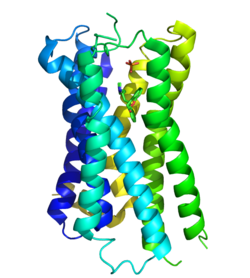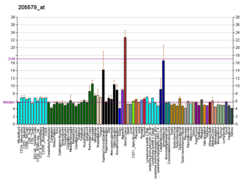组胺H1受体
外觀
H1受體是一種屬於視紫紅質樣G蛋白偶聯受體家族的受體,可被組織胺活化。它在平滑肌、血管內皮細胞、心臟、中樞神經系統中表現。H1受體與細胞內Gα蛋白的Gαq亞基連接,活化磷脂酶C和肌醇三磷酸(IP3)信號通路。作用於該受體的抗組織胺藥被用作抗過敏藥物。該受體的晶體結構已確定[6]並用於在基於結構的虛擬篩選研究中發現新的組織胺H1受體配體[7]
功能
[編輯]NF-κB(調節發炎過程的轉錄因子)的表現受到H1受體的固有活性以及與受體結合的促效劑的促進。[8]抗組織胺藥已被證明可以減弱NF-κB的表現並減輕相關細胞中的某些發炎過程。[8]
組織胺還可能在陰莖勃起中起作用。[9]
神經生物學
[編輯]組織胺H1受體被內源性組織胺活化,內源性組織胺是由下視丘結節乳狀體中的神經元釋放的。結節乳狀體的組織胺能神經元在「喚醒」周期中變得活躍,以大約2赫茲的頻率放電;而在慢波睡眠期間,該放電頻率降至大約0.5赫茲。[10]
結節乳狀體是一種組織胺能核,對調節睡眠-覺醒周期起重要作用。[11] 透過血腦屏障的H1拮抗劑可以抑制結節乳狀體投射的神經元上的H1受體的活性,這種作用可能是這些藥物造成嗜睡作用的原因。[來源請求]
參見
[編輯]參考文獻
[編輯]- ^ 對H1組織胺受體起作用的藥物;在維基數據上查看/編輯參考.
- ^ 2.0 2.1 2.2 GRCh38: Ensembl release 89: ENSG00000196639 - Ensembl, May 2017
- ^ 3.0 3.1 3.2 GRCm38: Ensembl release 89: ENSMUSG00000053004 - Ensembl, May 2017
- ^ Human PubMed Reference:. National Center for Biotechnology Information, U.S. National Library of Medicine.
- ^ Mouse PubMed Reference:. National Center for Biotechnology Information, U.S. National Library of Medicine.
- ^ Shimamura T, Shiroishi M, Weyand S, Tsujimoto H, Winter G, Katritch V, et al. Structure of the human histamine H1 receptor complex with doxepin. Nature. June 2011, 475 (7354): 65–70. PMC 3131495
 . PMID 21697825. doi:10.1038/nature10236.
. PMID 21697825. doi:10.1038/nature10236.
- ^ de Graaf C, Kooistra AJ, Vischer HF, Katritch V, Kuijer M, Shiroishi M, et al. Crystal structure-based virtual screening for fragment-like ligands of the human histamine H(1) receptor. Journal of Medicinal Chemistry. December 2011, 54 (23): 8195–8206. PMC 3228891
 . PMID 22007643. doi:10.1021/jm2011589.
. PMID 22007643. doi:10.1021/jm2011589.
- ^ 8.0 8.1 Canonica GW, Blaiss M. Antihistaminic, anti-inflammatory, and antiallergic properties of the nonsedating second-generation antihistamine desloratadine: a review of the evidence. The World Allergy Organization Journal. February 2011, 4 (2): 47–53. PMC 3500039
 . PMID 23268457. doi:10.1097/WOX.0b013e3182093e19.
. PMID 23268457. doi:10.1097/WOX.0b013e3182093e19. The H1-receptor is a transmembrane protein belonging to the G-protein coupled receptor family. Signal transduction from the extracellular to the intracellular environment occurs as the GPCR becomes activated after binding of a specific ligand or agonist. A subunit of the G-protein subsequently dissociates and affects intracellular messaging including downstream signaling accomplished through various intermediaries such as cyclic AMP, cyclic GMP, calcium, and nuclear factor kappa B (NF-κB), a ubiquitous transcription factor thought to play an important role in immune-cell chemotaxis, proinflammatory cytokine production, expression of cell adhesion molecules, and other allergic and inflammatory conditions.1,8,12,30–32 ... For example, the H1-receptor promotes NF-κB in both a constitutive and agonist-dependent manner and all clinically available H1-antihistamines inhibit constitutive H1-receptor-mediated NF-κB production ...
Importantly, because antihistamines can theoretically behave as inverse agonists or neutral antagonists, they are more properly described as H1-antihistamines rather than H1-receptor antagonists.15 - ^ Cará AM, Lopes-Martins RA, Antunes E, Nahoum CR, De Nucci G. The role of histamine in human penile erection. British Journal of Urology. February 1995, 75 (2): 220–224. PMID 7850330. doi:10.1111/j.1464-410x.1995.tb07315.x.
- ^ Passani MB, Lin JS, Hancock A, Crochet S, Blandina P. The histamine H3 receptor as a novel therapeutic target for cognitive and sleep disorders. Trends in Pharmacological Sciences. December 2004, 25 (12): 618–625. PMID 15530639. doi:10.1016/j.tips.2004.10.003.
- ^ Malenka RC, Nestler EJ, Hyman SE. Chapter 6: Widely Projecting Systems: Monoamines, Acetylcholine, and Orexin. Sydor A, Brown RY (編). Molecular Neuropharmacology: A Foundation for Clinical Neuroscience 2nd. New York: McGraw-Hill Medical. 2009: 175–176. ISBN 9780071481274.
Within the brain, histamine is synthesized exclusively by neurons with their cell bodies in the tuberomammillary nucleus (TMN) that lies within the posterior hypothalamus. There are approximately 64000 histaminergic neurons per side in humans. These cells project throughout the brain and spinal cord. Areas that receive especially dense projections include the cerebral cortex, hippocampus, neostriatum, nucleus accumbens, amygdala, and hypothalamus. ... While the best characterized function of the histamine system in the brain is regulation of sleep and arousal, histamine is also involved in learning and memory ... It also appears that histamine is involved in the regulation of feeding and energy balance.
延伸閱讀
[編輯]- Mitsuchashi M, Payan DG. Molecular and cellular analysis of histamine H1 receptors on cultured smooth muscle cells. Journal of Cellular Biochemistry. June 1989, 40 (2): 183–192. PMID 2670975. S2CID 43161416. doi:10.1002/jcb.240400207.
- Braman SS. Histamine receptors in the lung. New England and Regional Allergy Proceedings. 1987, 8 (2): 116–120. PMID 2886904. doi:10.2500/108854187778994446.
- Hill SJ, Ganellin CR, Timmerman H, Schwartz JC, Shankley NP, Young JM, et al. International Union of Pharmacology. XIII. Classification of histamine receptors. Pharmacological Reviews. September 1997, 49 (3): 253–278. PMID 9311023.
- Holden CA, Chan SC, Norris S, Hanifin JM. Histamine induced elevation of cyclic AMP phosphodiesterase activity in human monocytes. Agents and Actions. October 1987, 22 (1–2): 36–42. PMID 2891264. S2CID 23962587. doi:10.1007/BF01968814.
- Moguilevsky N, Varsalona F, Noyer M, Gillard M, Guillaume JP, Garcia L, et al. Stable expression of human H1-histamine-receptor cDNA in Chinese hamster ovary cells. Pharmacological characterisation of the protein, tissue distribution of messenger RNA and chromosomal localisation of the gene. European Journal of Biochemistry. September 1994, 224 (2): 489–495. PMID 7925364. doi:10.1111/j.1432-1033.1994.00489.x
 .
. - Fukui H, Fujimoto K, Mizuguchi H, Sakamoto K, Horio Y, Takai S, et al. Molecular cloning of the human histamine H1 receptor gene. Biochemical and Biophysical Research Communications. June 1994, 201 (2): 894–901. PMID 8003029. doi:10.1006/bbrc.1994.1786.
- Le Coniat M, Traiffort E, Ruat M, Arrang JM, Berger R. Chromosomal localization of the human histamine H1-receptor gene. Human Genetics. August 1994, 94 (2): 186–188. PMID 8045566. S2CID 13583779. doi:10.1007/bf00202867.
- De Backer MD, Gommeren W, Moereels H, Nobels G, Van Gompel P, Leysen JE, Luyten WH. Genomic cloning, heterologous expression and pharmacological characterization of a human histamine H1 receptor. Biochemical and Biophysical Research Communications. December 1993, 197 (3): 1601–1608. PMID 8280179. doi:10.1006/bbrc.1993.2662.
- Hishinuma S, Young JM. Characteristics of the binding of [3H]-mepyramine to intact human U373 MG astrocytoma cells: evidence for histamine-induced H1-receptor internalisation. British Journal of Pharmacology. November 1995, 116 (6): 2715–2723. PMC 1909113
 . PMID 8590995. doi:10.1111/j.1476-5381.1995.tb17232.x.
. PMID 8590995. doi:10.1111/j.1476-5381.1995.tb17232.x. - Max SI, Chowdhury BA, Fraser CM. Sequence analysis of the 5'-untranslated region of the human H1 histamine receptor-encoding gene. Gene. June 1996, 171 (2): 309–310. PMID 8666296. doi:10.1016/0378-1119(96)00036-4.
- De Backer MD, Loonen I, Verhasselt P, Neefs JM, Luyten WH. Structure of the human histamine H1 receptor gene. The Biochemical Journal. November 1998, 335 (Pt 3): 663–670. PMC 1219830
 . PMID 9794809. doi:10.1042/bj3350663.
. PMID 9794809. doi:10.1042/bj3350663. - Horváth BV, Szalai C, Mándi Y, László V, Radvány Z, Darvas Z, Falus A. Histamine and histamine-receptor antagonists modify gene expression and biosynthesis of interferon gamma in peripheral human blood mononuclear cells and in CD19-depleted cell subsets. Immunology Letters. November 1999, 70 (2): 95–99. PMID 10569698. doi:10.1016/S0165-2478(99)00126-1.
- Wang KY, Arima N, Higuchi S, Shimajiri S, Tanimoto A, Murata Y, et al. Switch of histamine receptor expression from H2 to H1 during differentiation of monocytes into macrophages. FEBS Letters. May 2000, 473 (3): 345–348. PMID 10818238. S2CID 772640. doi:10.1016/S0014-5793(00)01560-X.
- Oda T, Morikawa N, Saito Y, Masuho Y, Matsumoto S. Molecular cloning and characterization of a novel type of histamine receptor preferentially expressed in leukocytes. The Journal of Biological Chemistry. November 2000, 275 (47): 36781–36786. PMID 10973974. doi:10.1074/jbc.M006480200
 .
. - Brew OB, Sullivan MH. Localisation of mRNAs for diamine oxidase and histamine receptors H1 and H2, at the feto-maternal interface of human pregnancy. Inflammation Research. September 2001, 50 (9): 449–452. PMID 11603849. S2CID 28710647. doi:10.1007/PL00000269.
- Gutzmer R, Langer K, Lisewski M, Mommert S, Rieckborn D, Kapp A, Werfel T. Expression and function of histamine receptors 1 and 2 on human monocyte-derived dendritic cells. The Journal of Allergy and Clinical Immunology. March 2002, 109 (3): 524–531. PMID 11898002. doi:10.1067/mai.2002.121944.
- Idzko M, la Sala A, Ferrari D, Panther E, Herouy Y, Dichmann S, et al. Expression and function of histamine receptors in human monocyte-derived dendritic cells. The Journal of Allergy and Clinical Immunology. May 2002, 109 (5): 839–846. PMID 11994709. doi:10.1067/mai.2002.124044.
外部連結
[編輯]- Histamine Receptors: H1. IUPHAR Database of Receptors and Ion Channels. International Union of Basic and Clinical Pharmacology. [2023-12-15]. (原始內容存檔於2016-03-03).







